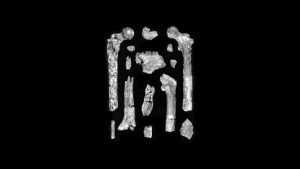
Orrorin tugenensis is one of the earliest hominins whose fossils were recovered from four areas in the Tugen Hills region of Kenya (Cheboit, Kapsomin, Kapcheberek, and Aragai). “Orrorin” means “original man” in the local Tugen dialect, and “tugenensis” pays tribute to the Tugen Hills region. The sediments in which the Orrorin specimens have been found are dated to between 6.0 and 5.8 million years ago using various lines of evidence including radioisotopic methods, paleomagnetism (dating accomplished using the timing of reversals in Earth’s magnetic poles), and biochronology (dating that utilizes the relative time frames of extinct nonhominin animals). O. tugenensis is important to hominin evolution because it (along with Sahelanthropus tchadensis from central Africa and Ardipithecus kadabba from eastern Africa) may represent some of the earliest evidence for bipedalism in the human fossil record.
Orrorin tugenensis is represented by 20 fossil specimens, coming from a minimum of five individuals. Specimens include teeth and lower jaw fragments, pieces of the humerus (the bone of the upper arm), partial femora (thigh bones), and a phalanx (finger bone). The molar teeth of O. tugenensis are smaller than in species of the genus Australopithecus and, in this respect, are similar to the 4.4-million-year-old hominin, Ardipithecus ramidus. The thickness of the dental enamel in O. tugenensis, however, is similar to that of Australopithecus afarensis and other australopiths (the group that includes all of the species in the genus Australopithecus), which have thicker enamel than Ar. Ramidus and living apes. The canine teeth of O. tugenensis are very primitive, similar to those of Ardipithecus kadabba, and resemble those of female chimpanzees in shape. The morphology (size and shape) of one of the O. tugenensis femora has led some researchers, including the discoverers, to suggest that it practiced bipedal locomotion similar to that of modern humans than Australopithecus afarensis. In particular, they argued that the preserved femoral neck (the part of the bone that connects the shaft of the femur to the head, which articulates with the pelvis) is longer than in living apes. Some of the muscle attachment areas on this portion of the femur have also been argued to indicate a shift toward bipedality even though other researchers contest this inference as inconclusive. The discoverers also argued that micro-computed tomography scans (micro-CT, an imaging technique, similar to x-ray, that permits researchers to observe the internal structures of bones) of the O. tugenensis proximal femur show that the cortical bone (outer layer of bone) of the femoral neck has differential thickness along the top and bottom surfaces; it is thickened inferiorly and thinner superiorly. This morphology was presented as further evidence to indicate that O. tugenensis was a biped. However, the published micro-CT scans are somewhat ambiguous, and the pattern found in O. tugenensis is also found in nonbipedal primates. Furthermore, some of the fossils attributed to O. tugenensis possess features that are considered specializations for arboreal locomotion (moving around in the trees). The O. tugenensis phalanx, for instance, is curved, similar to that of living apes. It should be noted, however, that indisputably bipedal hominins (e.g., Au. afarensis) also exhibit curved finger bones.
Currently, the debate over whether or not O. tugenensis was bipedal is unresolved. While some researchers are convinced by the features in this species that seem to indicate that it practiced bipedalism, others remain skeptical. Most researchers also agree that it belongs in the hominin family tree even though its evolutionary relationships with later hominin species are not well established. It is now clear from the fossil evidence that O. tugenensis practiced some form of bipedality and documents some of the earliest evidence for bipedal locomotion in the human fossil record and would shed light on the evolutionary causes of the shift to habitual bipedality. The geological age of O. tugenensis is close to the time when the lineages leading to humans and living chimps are thought to have diverged (based on molecular studies). Hence, evidence of bipedalism in this species would imply that some of the earliest hominin species that evolved after the split were bipedal, making this locomotor behavior one of the most important characteristics of our lineage.
The habitats in which O. tugenensis has been found are reconstructed as areas near lakes and streams. Evidence from nonhominin animals found at O. tugenensis sites (e.g., impalas and leaf monkeys) corroborates this finding, suggesting that O. tugenensis inhabited woodland environments. If O. tugenensis is bipedal, these environmental reconstructions would suggest that the earliest species practicing this form of locomotion evolved in more forested habitats, contrary to the once widely held belief that bipedality was an adaptation to life on the savanna.